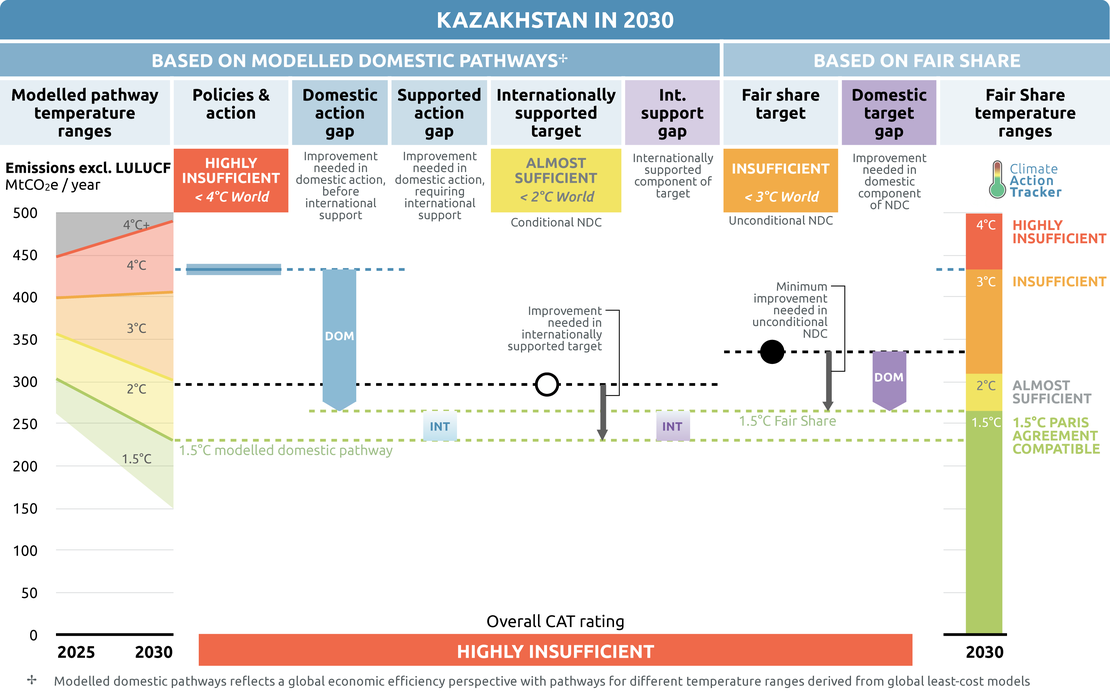Targets
Paris Agreement targets
NDC description
Kazakhstan signed the Paris Agreement on 2 August 2016 and ratified on 6 December 2016. Kazakhstan’s unconditional NDC target aims to reduce GHG emissions by 15% below 1990 levels (including LULUCF) by 2030. When excluding LULUCF emissions and using projections from the latest National Communication and UNFCCC inventory data, Kazakhstan’s target is equivalent to 17% below 1990 levels by 2030 (Republic of Kazakhstan, 2013, 2019b).
The NDC does not specify the LULUCF accounting method it will use. For simplicity, and in the absence of other information, this assessment assumes that the NDC is based on the 1990 emissions, including LULUCF. The size of Kazakhstan’s removals from the LULUCF sector are projected to stay between 1.2 and 9.6 MtCO2e until 2030 (based on the “with measures” scenario and “with additional measures” scenario, respectively) (Republic of Kazakhstan, 2019a). Based on this trend, future LULUCF removals are expected to have a minor impact. Kazakhstan also has a conditional target to reduce emissions (including LULUCF) by 25% below 1990 levels by 2030 (equivalent to 26% below 1990 levels, excluding LULUCF, by 2030). This target is subject to “additional international investments, access to low carbon technologies transfer mechanism, green climate funds and flexible mechanism for country with economy in transition” (Republic of Kazakhstan, 2016a).
Kazakhstan has stated it may use international market mechanisms to meet its NDC target, and that it “will consider adequately discounting international units for compliance to ensure a contribution to net global emission reductions” (Republic of Kazakhstan, 2016a). The impact of international market mechanisms on Kazakhstan’s NDC is not taken into account in this analysis.
The CAT rates Kazakhstan’s internationally supported target as “Almost sufficient” and its fair share target as “Insufficient”.
We rate the conditional NDC target as “Almost sufficient” when compared modelled emissions pathways. The “Almost sufficient” rating indicates that Kazakhstan’s internationally supported target for 2030 is not yet consistent with the Paris Agreement’s 1.5°C temperature limit but could be, with moderate improvements. If all countries were to follow Kazakhstan’s approach, warming could be held below—but not well below—2°C. The conditional target is close to the upper limit of this rating category, meaning that a small change in the numbers could lead to a worse rating.
We rate the unconditional NDC target as “Insufficient” when compared with its fair-share contribution to climate action. The “Insufficient” rating indicates that Kazakhstan’s fair share target in 2030 needs substantial improvements to be consistent with the Paris Agreement’s 1.5°C temperature limit. Kazakhstan’s target is at the least stringent end of what would be a fair share of global effort and is not consistent with the Paris Agreement’s 1.5°C limit, unless other countries make much deeper reductions and comparably greater effort. If all countries were to follow Kazakhstan’s approach, warming would reach over 2°C and up to 3°C.
Further information on how the CAT rates countries (against modelled pathways and fair share) can be found here.
Last NDC update
Up until the time of this assessment, Kazakhstan has not submitted an updated NDC. The failure to increase its mitigation ambition for 2030 does not comply with the Paris Agreement’s requirement that each successive NDC should present a progression beyond the current one.
Net zero and other long-term target(s)
Kazakhstan announced its intention to reach “carbon neutrality” (net zero CO2 emissions) by 2060 during the Climate Ambitions Summit in December 2020 (Satubaldina, 2021). Kazakhstan has not formally adopted a net zero target.
Kazakhstan has proposed a 2050 target of 25% reduction below 1992 levels excluding LULUCF (equivalent to an emission reduction of 33% below 1990 levels excluding LULUCF).
2020 pledge
Under the Copenhagen Accord, Kazakhstan proposed to reduce emissions by 15% below 1992 levels (incl. LULUCF) by 2020 (equivalent to an emission reduction of 26-27% below 1990 levels excluding LULUCF).
Kazakhstan submitted a QELRO1 (Quantified Emission Limitation or Reduction Objective) level of 95 for Kyoto Protocol’s second commitment period (CP2). This means that Kazakhstan’s average annual emissions from 2013–2020 are proposed to be 5% below 1990 levels. Kazakhstan’s intention to commit to this QELRO was conditional on being allowed to carry over its full surplus from the first commitment period, environmental integrity of the Kyoto Protocol, access to mechanisms for both periods and on a mid-term 2013–2015 review to increase the level of ambition in terms of emissions reductions among others.
However, paragraph 3.7ter of the Doha Amendment imposes a more ambitious emissions reduction target on Kazakhstan, as countries joining CP2 need to at least stabilise emissions in 2013–2020 to the average historical emission level over 2008–2010.2 This leads to a Kyoto pathway that is almost 77 MtCO2e per year lower than the direct translation of their target for the period 2013–2020. As of November 2020, Kazakhstan has not ratified the Doha Amendment, meaning that this commitment is not yet binding on Kazakhstan under international law. As the Doha Amendment ratification deadline was 2 October 2020, it seems unlikely that Kazakhstan will still do so.
1 | The QELRO, expressed as a percentage in relation to a base year, denotes the average level of emissions that an Annex B Party could emit on an annual basis during a given commitment period.
2 | This is part of the Doha decisions and constitutes part of the amendments to the Kyoto Protocol. Amendments only come into effect once they are ratified by Parties.
Further analysis
Latest publications
Stay informed
Subscribe to our newsletter







